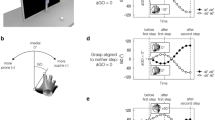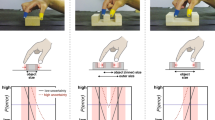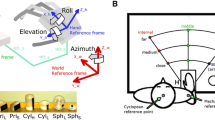Abstract
The grasp orientation when grasping an object is frequently aligned in anticipation of the intended rotation of the object (end-state comfort effect). We analyzed grasp orientation selection in a continuous task to determine the mechanisms underlying the end-state comfort effect. Participants had to grasp a box by a circular handle—which allowed for arbitrary grasp orientations—and then had to rotate the box by various angles. Experiments 1 and 2 revealed both that the rotation’s direction considerably determined grasp orientations and that end-postures varied considerably. Experiments 3 and 4 further showed that visual stimuli and initial arm postures biased grasp orientations if the intended rotation could be easily achieved. The data show that end-state comfort but also other factors determine grasp orientation selection. A simple mechanism that integrates multiple weighted biases can account for the data.







Similar content being viewed by others
Notes
With the term “anticipatory grasp orientations”, we refer to grasp orientations that have an anticipatory component.
The rotation angle can assume both positive and negative values
The effect of the context is unlikely to be cancelled out by the different ratios of women and men participating in Experiments 1 and 2 (c.f. Fischman 1998), because similar results are obtained if only women are included in the analysis (for all interactions p > 0.23).
Grasp selection may be biased by optical illusions (Crajé et al. 2008). However, here we did not want to create an illusion that distorted the perceived orientation of the object that was to be grasped, but wanted to suggest a certain way of grasping and turning the box to the participants.
Note that we only included the arrow start position left and right because they are the conditions that can be interpreted most easily.
We thank an anonymous reviewer for suggesting this explanation.
We used the matlab function fminsearchbnd (http://www.mathworks.com/matlabcentral/fileexchange/8277-fminsearchbnd) to determine values that result in the smallest root mean square error for each participant. We constrained the values of p anti,cw, p anti,ccw, and p const to [−200°,200°]. As each participant provided only three data points in Experiment 2, the model, which has four free parameters in the case of Experiment 2, fits the data trivially (R 2 = 1.0).
References
Adalbjornsson, C. F., Fischman, M. G., & Rudisill, M. E. (2008). The end-state comfort effect in young children. Research Quarterly for Exercise and Sport, 79, 36–41.
Bubic, A., von Cramon, D. Y., & Schubotz, R. I. (2010). Prediction, cognition and the brain. Frontiers in Human Neuroscience, 4, 1–15.
Butz, M. V., Herbort, O., & Hoffmann, J. (2007). Exploiting redundancy for flexible behavior: Unsupervised learning in a modular sensorimotor control architecture. Psychological Review, 114(4), 1015–1046.
Chapman, K. M., Weiss, D. J., & Rosenbaum, D. A. (2010). Evolutionary roots of motor planning: The end-state comfort effect in lemurs. Journal of Comparative Psychology, 124(2), 229–232.
Cisek, P. (2006). Integrated neural processes for defining potential actions and deciding between them: A computational model. Journal of Neuroscience, 26(38), 9761–9770.
Cohen, R. G., & Rosenbaum, D. A. (2004). Where grasps are made reveals how grasps are planned: Generation and recall of motor plans. Experimental Brain Research, 157, 486–495.
Coren, S. (1993). The lateral preference inventory for measurement of handedness, footedness, eyedness, and earedness: Norms for young adults. Bulletin of the Psychonomic Society, 31(1), 1–3.
Crajé, C., van der Kamp, J., & Steenbergen, B. (2008). The effect of the “rod-and-frame” illusion on grip planning in a sequential object manipulation task. Experimental Brain Research, 185, 53–62.
Engelbrecht, S. E. (2001). Minimum principles in motor control. Journal of Mathematical Psychology, 45, 497–542.
Erlhagen, W., & Schöner, G. (2002). Dynamic field theory of movement preparation. Psychological Review, 109(3), 545–572.
Fischer, M. H., Rosenbaum, D. A., & Vaughan, J. (1997). Speed and sequential effects in reaching. Journal of Experimental Psychology: Human Perception and Performance, 23(2), 404–428.
Fischman, M. G. (1998). Constraints on grip-selection: Minimizing awkwardness. Perceptual and Motor Skills, 86, 328–330.
Flash, T., & Hogan, N. (1985). The coordination of arm movements: An experimentally confirmed mathematical model. The Journal of Neuroscience, 5(7), 1688–1703.
Haggard, P. (1998). Planning of action sequences. Acta Psychologica, 99(2), 201–215.
Harris, C. M., & Wolpert, D. M. (1998). Signal-dependent noise determines motor planning. Nature, 394, 780–784.
Herbort, O., & Butz, M. V. (2007). Encoding complete body models enables task dependent optimal control. Proceedings of the International Joint Conference on Neural Networks 20, 1639–1644.
Herbort, O., & Butz, M. (2010). Planning and control of hand orientation in grasping movements. Experimental Brain Research, 202(4), 867–878.
Hughes, C. (1996). Brief report: Planning problems in autism at the level of motor control. Journal of Autism and Developmental Disorders, 26(1), 99–107.
Johnson, S. H. (2000). Thinking ahead: The case for motor imagery in prospective judgements of prehension. Cognition, 74(1), 33–70.
Kelso, J. A. S., Buchanan, J. J., & Murata, T. (1994). Multifunctionality and switching in the coordination dynamics of reaching and grasping. Human Movement Science, 13(1), 63–94.
Knill, D. C., & Pouget, A. (2004). The bayesian brain: The role of uncertainty in neural coding and computation. Trends in Neurosciences, 27(12), 712–719. doi:10.1016/j.tins.2004.10.007.
Marotta, J. J., Medendorp, W. P., & Crawford, J. D. (2003). Kinematic rules for upper and lower arm contributions to grasp orientation. Journal of Neurophysiology, 90, 3816–3820.
Matsuoka, J., Berger, R. A., Berglund, L. J., & An, K.-N. (2006). An analysis of symmetry of torque strength of the forearm under resisted forearm rotation in normal subjects. The Journal of Hand Surgery, 31(5), 801–805.
O’Sullivan, L., & Gallwey, T. (2005). Forearm torque strengths and discomfort profiles in pronation and supination. Ergonomics, 48(6), 703–721.
Pezzulo, G., Butz, M. V., Gastelfranchi, C., & Falcone, R. (2008). The challenge of anticipation: A unifying framework for the analysis and design of artificial cognitive systems. Berlin: Springer.
Robert, T., Beurier, G., & Wang, X. (2009). Arm postural anticipation for rotating a spherical object. Computer Methods in Biomechanics and Biomedical Engineering, 12(1), 217–218.
Rosenbaum, D. A., Cohen, R. G., Jax, S. A., Weiss, D. J., & van der Wel, R. (2007). The problem of serial order in behavior: Lashley’s legacy. Human Movement Science, 26, 525–554.
Rosenbaum, D. A., Halloran, E. S., & Cohen, R. G. (2006). Grasping movement plans. Psychonomic Bulletin & Review, 13(5), 918–922.
Rosenbaum, D. A., & Jorgensen, M. J. (1992). Planning macroscopic aspects of manual control. Human Movement Science, 11(1–2), 61–69.
Rosenbaum, D. A., Loukopoulos, L. D., Meulenbroek, R. G. J., Vaughan, J., & Engelbrecht, S. E. (1995). Planning reaches by evaluating stored postures. Psychological Review, 102(1), 28–67.
Rosenbaum, D. A., Marchak, F., Barnes, H. J., Vaughan, J., Siotta, J. D., & Jorgensen, M. J. (1990). Constraints for action selection: Overhand versus underhand grips. In M. Jeannerod (Ed.), Attention and Performance, Vol. XIII (pp. 321–345). Hillsdale: Lawrence Erlbaum Associates.
Rosenbaum, D. A., Meulenbroek, R. G. J., Vaughan, J., & Jansen, C. (2001). Posture-based motion planning: Applications to grasping. Psychological Review, 108(4), 709–734.
Rosenbaum, D. A., van Heugten, C. M., & Caldwell, G. E. (1996). From cognition to biomechanics and back: The end-state comfort effect and the middle-is-faster effect. Acta Psychologica, 94, 59–85.
Rosenbaum, D. A., Vaughan, J., Barnes, H. J., & Jorgensen, M. J. (1992). Time course of movement planning: Selection of handgrips for object manipulation. Journal of Experimental Psychology. Learning, Memory, and Cognition, 18(5), 1058–1073.
Rosenbaum, D. A., Vaughan, J., Jorgensen, M. J., Barnes, H. J., & Stewart, E. (1993). Plans for object manipulation. In D. E. Meyer & S. Kornblum (Ed.), Attention and performance XIV—a silver jubilee: Synergies in experimental psychology, artificial intelligence and cognitive neuroscience (pp. 803–820). Cambridge: MIT Press/Bradford Books.
Schütz, C., Weigelt, M., Odekerken, D., Klein-Soetebier, & Schack, T. (in press). Motor control strategies in a continuous task space. Motor Control.
Short, M. W., & Cauraugh, J. H. (1999). Precision hypothesis and the end-state comfort effect. Acta Psychologica, 100(3), 243–252.
Soechting, J. F., Buneo, C. A., Herrmann, U., & Flanders, M. (1995). Moving effortlessly in three dimensions: Does donders’ law apply to arm movement? Journal of Neuroscience, 15, 6271–6280.
Steenbergen, B., Hulstijn, W., & Dortmans, S. (2000). Constraints on grip selection in cerebral palsy: Minimising discomfort. Experimental Brain Research, 134, 385–397.
Thibaut, J.-P., & Toussaint, L. (2010). Developing motor planning over ages. Journal of Experimental Child Psychology, 105(1–2), 116–129.
Todorov, E. (2004). Optimality principles in sensorimotor control. Nature Review Neuroscience, 7(9), 907–915.
van der Vaart, A. J. M., (1995). Arm movements in operating rotary control (Doctoral thesis, Technische Universiteit Delft, Delft, The Netherlands). http://repository.tudelft.nl/assets/uuid:20033739-71d9-42a4-bc3e-058d78ab8cec/ide_vaart_19950616.PDF.
van Swieten, L. M., van Bergen, E., Williams, J. H., Wilson, A. D., Plumb, M. S., Kent, S. W., et al. (2010). A test of motor (not executive) planning in developmental coordination disorder and autism. Journal of Experimental Psychology: Human Perception and Performance, 36(2), 493–499.
Weigelt, M., Rosenbaum, D. A., Huelshorst, S., & Schack, T. (2009). Moving and memorizing: Motor planning modulates the recency effect in serial and free recall. Acta Psychologica, 132(1), 68–79.
Weiss, D. J., Wark, J. D., & Rosenbaum, D. A. (2007). Monkey see, monkey plan, monkey do: The end-state comfort effect in cotton-top tamarins (Saguinus oedipus). Psychological Science, 18(12), 1063–1068.
Wolpert, D. M., & Ghahramani, Z. (2000). Computational principles of movement neuroscience. Nature Neuroscience, 3, 1212–1217.
Zhang, W., & Rosenbaum, D. A. (2008). Planning for manual positioning: The end-state comfort effect for manual abduction-adduction. Experimental Brain Research, 184, 383–389.
Acknowledgments
The authors acknowledge funding from the Emmy Noether program of the German Research Foundation (grant BU1335/3-1), thank Georg Schüssler for technical support, and thank David Rosenbaum and John Buchanan for comments on an earlier version of this manuscript.
Author information
Authors and Affiliations
Corresponding author
Electronic supplementary material
Below is the link to the electronic supplementary material.
Rights and permissions
About this article
Cite this article
Herbort, O., Butz, M.V. The continuous end-state comfort effect: weighted integration of multiple biases. Psychological Research 76, 345–363 (2012). https://doi.org/10.1007/s00426-011-0334-7
Received:
Accepted:
Published:
Issue Date:
DOI: https://doi.org/10.1007/s00426-011-0334-7




